 Xperiencing the SonyEricsson Xperia X10
Xperiencing the SonyEricsson Xperia X10
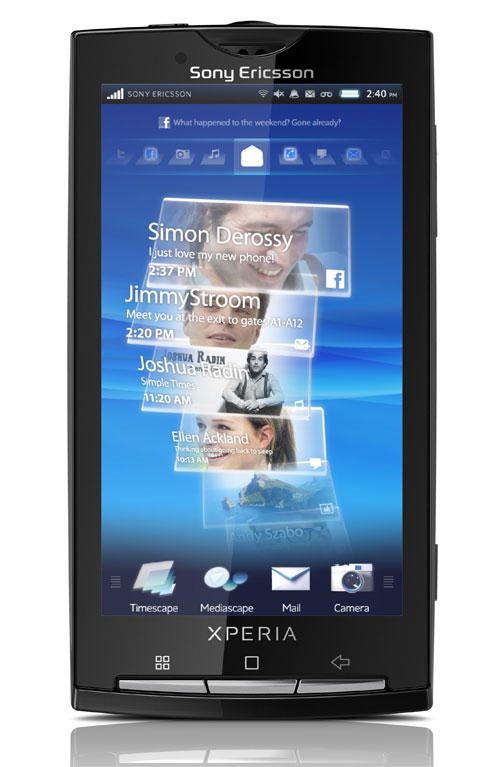 Product Category: Android Smartphone (non-keyboard)Where to Buy: Expansys [affiliate] (unit tested is from Rogers in Canada)Price: $499.95USD for an unlocked version.System Requirements: Currently running Android v1.6. (2.1 upgrade is due by Dec. 2010)Specifications: CPU - Qualcomm 8250 Snapdragon @ 1Ghz; Battery - 1500 mAh; Display - 4 in. (10.2 cm) 480x854 pixel TFT Capacitive touch 65K colours; Memory - 1G storage, 384M RAM, MicroSD card; Camera - 8mp, 16x zoom (digital), LED photo light; 802.11b/g; Quad-band GPRS; BT 2.1; 3.5mm audio; Accelerometer; Proximity Sensor; MicroUSB charging/sync connector; 119mm (4.7in) x 63mm (2.48in) x 13mm (0.51in); 135g (4.8oz).Pros: - Big, bright screen;
- Radios (cellular, BT, WiFi, and GPS) are very sensitive, very stable;
- Rogers' version comes with a massive 16G microSD card.
Cons: - Volume is adequate, but lacks 'range';
- Curious intraction between BT and GPS;
- Way behind in Android updates -- still only at v1.6.
Summary: The XPeria X10 from Sony Ericsson was big news about 6 or 7 months ago, and it's still the phone Rogers (here in Canada) touts as its 'high end' Android-based smartphone. We see new smartphones being introduced almost daily, especially in the Android space, so how does the X10 fare against the current crop of phones? And with the recent announcement of Windows Phone 7, how does it compare?
IntroductionEver since my first integrated phone running Pocket PC Phone Edition, I've used Windows Mobile phones almost exclusively. (I did have a RAZR for a while, but quickly dropped that as soon as touch-screen capable phones were available). Then, with the launch of the Google Android phone, I've been wanting to take one out for a bit of a test drive to take a close-up look at the Android O/S and see if there really were any major differences in the interface. Well, the opportunity presented itself a month or so ago when I came to the end of a 3-year commitment on my current batch of cell phones with Rogers. (Yes, I guess I could have bought an unlocked phone and stuck in the SIM card, but since the contract was coming up, I thought I'd wait to see if I could get one cheaper from the provider.) I was able to re-negotiate my service package and upgrade both my son and myself to Rogers' high-end Android phone, the Xperia X10 for about $150 (CAD) When we asked, the salesmen (at numerous stores) assured us it was running Android 2.1, and that an upgrade to 2.2 was imminent 'in the next month or so'. Unfortunately, our fears regarding the technical knowledge of the staff at the stores was borne out. When I picked up the phone, I immediately checked it and found it was still running 1.6.:-( I checked in the Sony Ericsson user forums and it appears S-E just got their package for 2.1 a month or so ago and is working on the upgrade. They hope to have it done by the end of October, which means Rogers will probably roll it out sometime in November or December. (No word from S-E on a 2.2 or even 2.3 upgrade) Oh well.... [Update] -- Nov. 15th -- I'm just downloading the 2.1 upgrade from Rogers/SE now (very slowwwwwlllllyyy), so I'll add a bit later as to how it looks. What Comes in the PackageIt looks like the packaging provided by Rogers is direct from Sony Ericsson, as there doesn't appear to be any additional branding applied anywhere (including on the phone itself). Most of what is included is what you'd expect to find. I was surprised, however, not to find the usual CD of PC-based sync software and user manuals. Maybe that's normal now for Android phones. 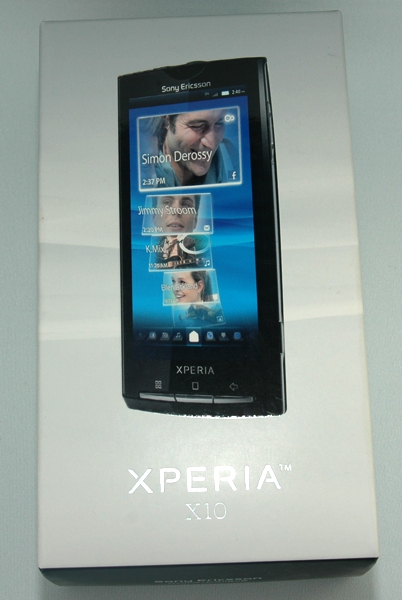
Figure 1: A shot of the box the XPeria X10 comes in. Very clean lines while trying to bridge the gap between consumer and professional presentation. 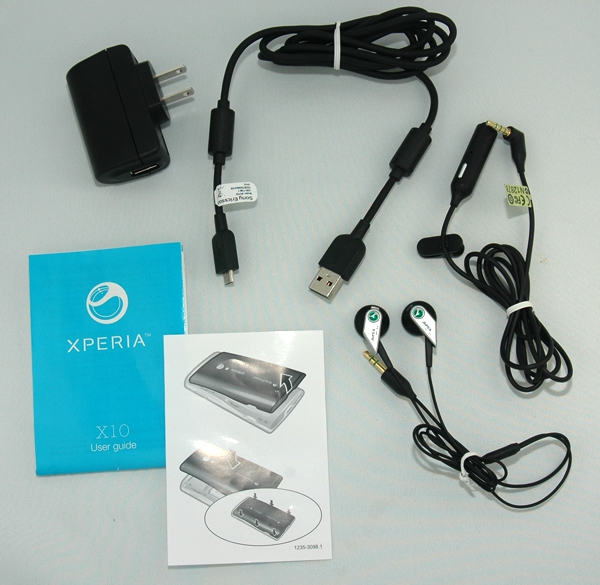
Figure 2: The contents of the X10 package. Clockwise from the top left, it includes a wall adapter with a USB outlet; a USB to microUSB charging/synchronization cable; a microphone extension cable for the earbuds with a 3.5mm plug; good quality "bass reflex" earbuds, again with a 3.5mm stereo phone plug; a quick start guide of how to remove the back to install the SIM card, microSD card, and battery; and a fold out User Guide on a single piece of paper (in very small print).
Exterior ShotsTaking a quick look around the exterior of the phone, the design has definitely focused on keeping things lean and mean -- taking maximum advantage of the space provided by the extra screen landscape. 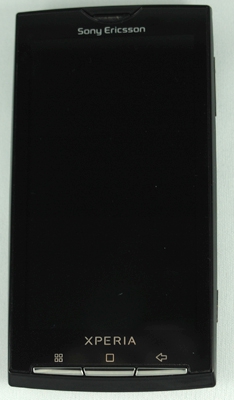 Figure 3: Here's a shot of the front of the X10. At the top, just over the S/E logo is the earpiece/speaker. Sorry, no front-facing camera for video calling, but that's fairly standard for North American phones. At the bottom are three hardware buttons which activate (from left to right) an application-specific menu, home, and go back one screen. When any of the buttons is pushed, white LEDs light up in the two slots between the buttons. They're pretty helpful in the dark. 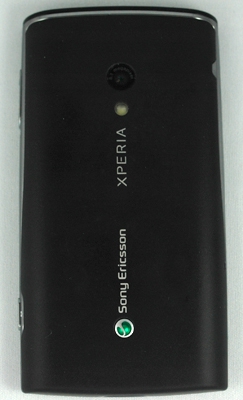
Figure 4: A shot of the back of the unit. Not much here except the lens for the 8Mp camera (near the top) with the LED photo 'light' just below it. Note, activation of the photo light is an on-off affair from the menus in the camera app. It simply comes on and stays on until you turn it off. It doesn't 'flash' when you take a picture. 
Figure 5: Not much to see on the left side of the unit. There definitely seems to be a move to a minimalist approach in phone design recently. The chrome accent is a nice touch though. 
Figure 6: On the right side of the unit, you see the Camera button on the left of the picture, and the Volume Down/Up rocker button at the right. The Volume buttons also affect zoom on the display in applications like the camera and the browser.
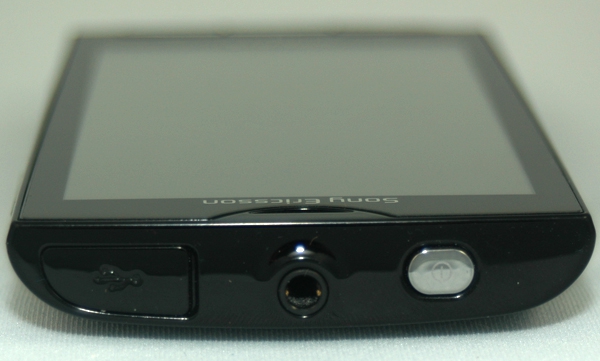
Figure 7: On the top of the unit, you see the microUSB jack on the left side of the picture (with a plastic cover, attached via a small, flimsy plastic hinge), followed by the 3.5mm phone jack for audio and microphone in the centre, and the power/sleep button on the right side. There's nothing on the bottom except the microphone and what looks like a hook for a lanyard. 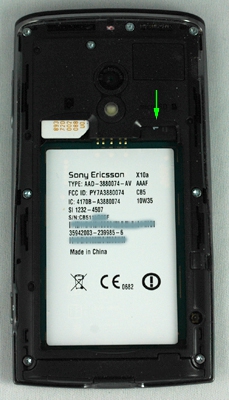
Figure 8: A shot of the X10 with the back removed. At the top left you can see the SIM card slot. On the right (under the green arrow) is where the microSD card slides in. While most of the sales information I've seen talks about 8GB being provided, Rogers supplied a 16GB microSD card. Sweet! You know, after re-reading the hardware specification requirements from Microsoft for Windows Phone 7 (3 buttons, capacitive screen, Snapdragon processor...), I'd almost be tempted to think Sony Ericsson had these in mind when they designed the X10. But, I wouldn't want to start any completely unfounded rumours...:-) Comparisons...So how does the X10 compare physically to the other 'big screen' phones/multimedia devices available out there? To be fair, it would have been better (at least with respect to screen size) to compare this to an HTC HD, but I don't have one of those handy at the moment :-). So, instead, here are some comparison shots to an HTC TD2 (aka the ATT PURE) which was, at one point, thought to be an iPhone 'killer' :-)  Figure 9: A side-by-side shot comparing the X10 (left) with the TD2 (right). Just look at the amount of extra screen landscape available on the X10! Also notice that the X10 is following the latest trend of NOT having dedicated hardware buttons for call pickup and hangup. 
Figure 10: A side-by-side comparison of the HTC Touch Diamond 2 (on top) and the XPeria X10 (on the bottom). As you can see, the X10 is considerably thinner and hence, much lighter. Generally, the X10 feels a lot lighter and less bulky in the hand and in the pocket than the HTC unit. Although significantly wider, it doesn't feel uncomfortable to hold and can, for the most part, be operated with one hand. The only difficulty might be actuating the power/sleep button at the top left. UXP -- Sony's Android UIAs with most manufacturers, Sony Ericsson decided to enhance the standard Android user experience in order to create their own flavor and provide some differentiation. Called UXP (or UX Platform), it is essentially an overlay to the Android OS, much like HTC's Sense overlay for Windows Mobile. Apparently, this is being exensively updated for Android 2.1 to include many of the 2.2 features (according to S/E) -- which is why it's taking so long to get a 2.1 upgrade out the door. We'll have to see how that presents itself. While I'm not an Android expert, the main difference I see is in the addition of two applications -- Timescape, which provides a single thread display for events -- like emails and phone calls; and Mediascape for playing all types of audio, video, and photos. Everything else seems to be pretty standard stuff for Android 1.6. 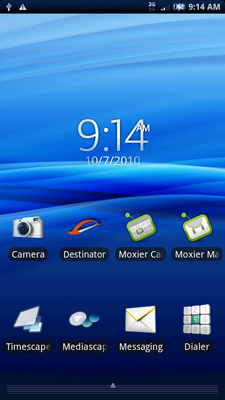 Figure 11: Here's a screen shot of the Home screen on the X10. This is one of 3 panels on the home screen, which are accessible by scrolling left or right. At the top of the screen is the Notification and Status bar which can be scrolled down to reveal more details about the notifications. At the bottom is the scroll hint (multiple lines with the up arrow) for showing all the applications available. I added the top line of application widgets. 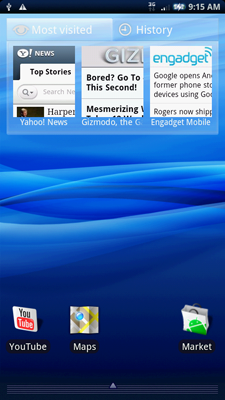
Figure 12: The second panel of the standard Home screen showing the web history widget at the top and some app access icons at the bottom. This is pretty much exactly how it comes out of the box. I haven't modified this screen or added any new widgets. 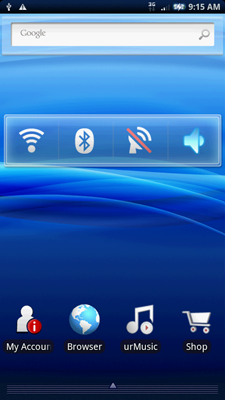
Figure 13: The third Home screen panel, again as it comes out of the box. There's a web search widget at the top, and application widgets at the bottom. Rogers was pretty good about not putting too much 'bloatware' on the phone to brand it. The only additions I've found are the My Account and urMusic widgets shown. The Communications widget in the middle provides an easy one-stop access to turning on an off all of the radios and audio on the unit. From left to right they are: WiFi; Bluetooth; Location Services (GPS); and the speaker/ringtones. The speaker/ringtones cycles through audible, vibrate only, and off. 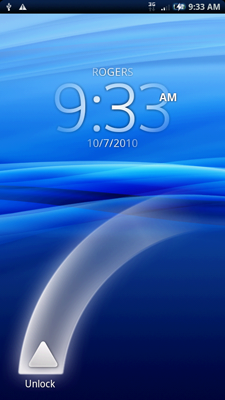 Figure 14: A shot of the standard lock screen provided. From the Settings, it is possible to reverse the swoop to right to left, or to establish a different unlock pattern. 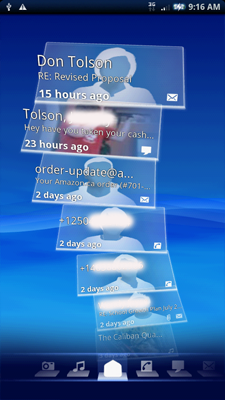 Figure 15: A screenshot of the Timescape application, showing the Email panel. Timescape displays events which occur in a number of categories -- such as email, music listened to, photos taken (or loaded), messages, etc. They are displayed as panels arranged in a time-ordered spline which looks like a backbone. You can scroll up and down the splines and select entries from any point. Scrolling left and right moves between the various splines/timelines. 
Figure 16: Mediascape provides a one-stop place to access music, video and photos loaded on your phone. The More button at the top right gives options for different ways of accessing the items. 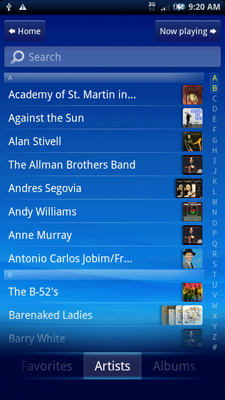
Figure 17: Here's the Artists panel for music in Mediascape. It's a nice touch to show the album art for all the albums associated with each artist. RadiosThe radios are really the 'heart' of any smartphone, since they provide communication to the rest of the world -- whether it be voice or data via GPRS; Internet via WiFi; or Location positioning via GPS. I've spent a lot of time working with and tweaking the capabilities of the radios with various Windows Mobile units I've owned over the years. I have to admit, I was very pleasantly suprised at the capabilities of the X10's communications right out of the box. GPRS (Cellular)The X10 comes with the standard quad band cellular radio which handles GSM, Edge and 3G (including HSDPA and HSUPA) data connections (GSM 850/900/1800/1900, HSDPA 900/1700/2100 - European and T-Mobile, HSDPA 850/1900/2100/800 for other NA). The version supplied by Rogers handles the 3G frequencies for their network here in Canada which are similar to the 3G frequencies used by AT&T in the US, so you should be able to get onto their 3G network with no problems. There was no evidence that it was using the higher 'H' speeds, but that could be due to a limitation of the icons provided in the notifications bar at the top of the screen. Sensitivity (# of bars) seems to be equivalent to all of the other high-end phones I've owned and I've never had a problem getting connection or with calls dropping. 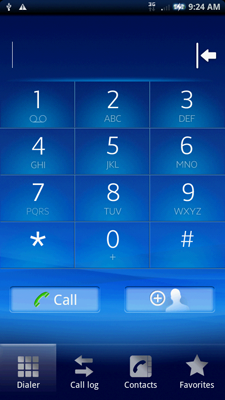
Figure 18: A screenshot of the dialer on the X10. Nothing particularly special here. There is an option to have beeps on each keypress, but I found that slowed down the response time too much. 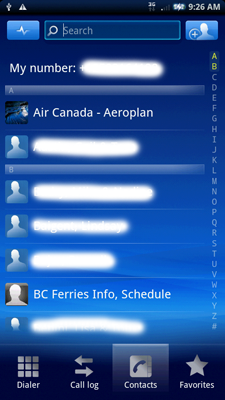 Figure 19: A look at the Contacts list. Again pretty standard stuff. One niggle is that when you select a Contact with multiple contact numbers, you get the expected screen asking which one to use, but after selecting one, you go back to the Dialer screen with the number filled in but it doesn't automatically dial. You have to press 'Call' to get it to dial. 
Figure 20: The call log is fairly standard as well. Here though, if you press the call icon (green phone) to the left of the entry, it will directly dial the number (which is as it should be...). There doesn't seem to be a limit on the length of the call log as mine currently goes back to when I first got the phone. BluetoothThe Bluetooth radio and stack provided with the X10 supports v2.1 with A2DP. I had no problem pairing it up with my stereo headset (Motorola) and phone earpiece (Helium Digital). It also easily paired up with the family Toyota Prius. The range of the BT is pretty similar to the other smartphones I've owned, typically 25 to 30 feet (10m) within the house or office. As with other audio portions of the X10 (which I'll talk more about later), I found the BT volume range to be rather limited. Yes, there's sufficient volume for phone calls and listening to music, but you're at the top of the volume control. There just isn't any more oomph available for softer passages or noisy environments. WiFiThe 802.11 b/g receiver in the X10 is much better than all the other phones I've owned or tested. The X10 is easily able to connect into the router from anywhere in the house, and even in the back yard. The signal stability is excellent with no dropped connections and good data transfer rates. GPSHere, the X10's GPS receiver also excels. It is noticeably more sensitive than any other phone I've had. Location lock is achieved in seconds, even after a reset (power down, then power up again) which usually clears out the memory in the GPS chip, so it has to download the satellite almanac data again. (No, I don't have AGPS turned on.) The receiver is also able to pull in signals inside buildings and structures that were totally blank with other phones. I did notice, however, that if the Bluetooth is activated first, then you attempt to use the GPS, the software can't find the internal receiver (perhaps it's looking for a BT-connected one?). If you start up the GPS first, establish connection to the internal reciever first, then turn on the BT, everything works fine. FMI have no evidence to support this, but I suspect the Snapdragon chipset includes an FM receiver. Unfortunately, there seems to be no way to access it. There is no FM radio application included in the package from Rogers, and there is nothing specific mentioned in the specs from S/E. That's too bad, since, while I don't use it often, it's nice to have it for a change of pace from the stored music.
Software IncludedAs mentioned above, Rogers has been gracious to its customers in not overloading the X10 with bloatware. The only additions I noticed were the myAccount widget (which tells you how much data and voice time you've used) and the urMusic applcation which is Rogers' answer to iTunes -- a combination media player and Internet music store. In the US and Europe, I believe the PlayNow application is used instead. Sony Ericsson's contribution to the phone is the UXP overlay with the Timescape and Mediascape applications, to which they have also added some useful widgets and applications. As far as I can tell, here's what's been added to the base Android system: - Office Suite -- view (no modify) of MS Office docs, spreadsheets, etc.;
- Shop -- connect to Rogers web site for accessories, etc.;
- Wisepilot -- turn by turn navigation (30 day trial, needs annual subscription, limited coverage);
- Track ID -- music recognition;
- Speed Test -- web access speed;
- Moxier Suite -- sync to MS Outlook contacts, email, tasks, etc. (full version, but not current);
- S/E backup & restore -- to SD Card?;
- Facebook client;
- Email and Gmail (non-Outlook email clients);
- Google Talk;
- Google Maps;
- Market -- Android Market Client;
- Messaging -- SMS and MMS application;
- Phone Book -- contacts list (integrates with Moxier/Outlook contacts);
- S/E Sync -- cloud-based sync of contacts, calendar, etc.;
- urMusic -- media player and online music store from Rogers (requires licence/subscription);
- Voice Dialer -- voice activated functions; and
- YouTube client.
On the PC side, Sony-Ericsson provides two pieces of software to connect the X10 to your laptop/desktop and beyond. The PC Companion is automatically installed the first time you connect the phone via USB. 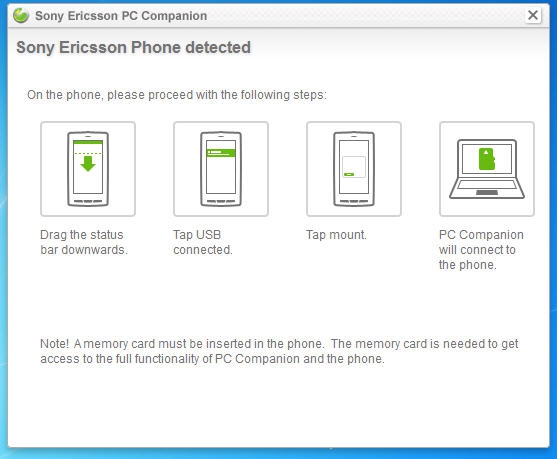
Figure 21: After installation of the PC Companion software, this is the screen presented when the X10 is connected. Two annoying things about this: a) it keeps re-appearing if you close the window without 'mounting' the SD card via the USB connection; and b) once you do, the SD card is no longer available to apps running on the phone, so your music stops playing. 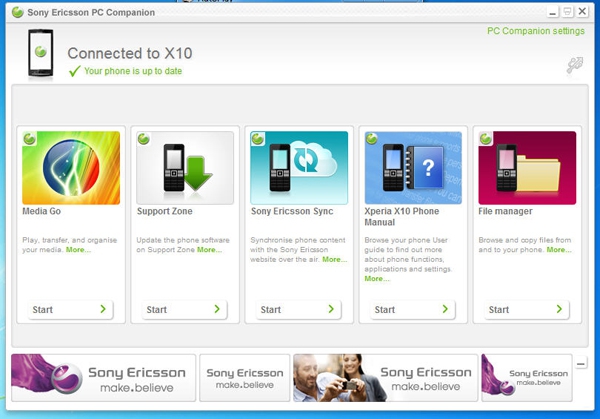 Figure 22: Here is the main screen of PC Companion, (available only AFTER you mount the SD card as per the instructions above). It provides access to various integration options between the phone and the PC. The functions are pretty much as explained in each of the panels. The PC also gets an application called MediaGo which is yet another media organizer. I don't know when this was installed (I suspect as part of the PC Companion package) but there's a desktop icon which I didn't ask for and there is no way to uninstall it, as it doesn't show up in the list of applications in the PC's Control Panel. The accelerometer in the X10 works very well for determining the positioning of the phone. I was able to download a version of Google Sky from the Android market and it works as well as the iPad version, showing a window on a star map of the night sky as you turn around. Pretty cool. The unit also supposedly includes a proximity sensor similar to some of the HTC models. My experience with it, though, is that I don't think it's working quite right. It should turn the screen off automatically as you bring the unit to your face, but a number of times I've activated functions while I've been talking on the phone and/or listening to a voicemail message. Also, S/E has included an annoying 'Tap twice' function to allow access to the keypad in the middle of a call. Why can't it work the way HTC's Tilt2 works and simply know that the phone is no longer against my face?
BatteryThe battery is a fairly good sized 1500mAh Lithium-Polymer unit which, according to the specs, should be able to provide 415h of standby and 10h of talk time. Generally, I've been able to go about a day and a half, maybe two days, with what I would consider moderate use. As is usual with smartphones, use of 3G, WiFi and GPS eat into these times tremendously. All in all, I was also very impressed with the power management arrangements for the radios. In the Windows Mobile world, there are lots of accessory apps for making sure various power-hungry radios (WiFi and GPS are the notable beasts here) are turned on and off only as needed. But with the X10 and, I'm guessing, Android, they seem to have figured this out right in the O/S. I noticed that location services (GPS) only came on when it was needed and turned off when the app was exitted, and WiFi turns off automatically when the unit goes into sleep mode. It is definitely a bonus not having to worry about these as part of battery management. Charging from any USB port seems to work fine, taking about 5 to 6 hours from a dead state. Unfortunately, the only only wall charger I've been able to get working with the X10 is the one from S/E. All the others I have with the same standard USB receptical accepted the charge/sync cable, but would not set the X10 into charge mode. This is strange, since the chargers work fine with other phones -- even those which require a lot more power. ScreenOf course, the biggest selling feature of the X10 is the screen. At 4 inches (10.1cm) it's among the largest of any smartphone on the market. As noted in the specifications, it's a TFT capacitive sensor capable of showing over 65,000 colours. Unfortunately is doesn't support multi-touch, so no pinch to zoom, but the touch sense action is smooth and reliable. The screen is very bright, making it easily visible outside even in direct sunlight. Because the surface is smooth and glossy, it's very susceptible to smudges, and I found adding a screen protector only made things worse. The automatic brightness setting in the operating system makes the screen too dim to view through the protector. CameraThe camera included in the X10 is an 8Mp unit (3264x2449) with autofocus, 16x digital zoom, and a photo 'light', which is turned on and off manually, rather than flash with the shutter. That seemed pretty lame to me. Options include touch focus, image stabilization, geo-tagging, face and smile recognition. Sorry, as mentioned before, there is no front facing camera for video calling. The pictures taken by the X10 are pretty reasonable for a phone camera. Below, are a couple of photos taken with the X10 with no processing, other than resizing to our standard review format.  Figure 23: An outdoor shot taken of the Victoria harbour (about a 3 minute walk from where I work) on a sunny day in late October. (Yep, it's ALWAYS like this here in Camelot!) 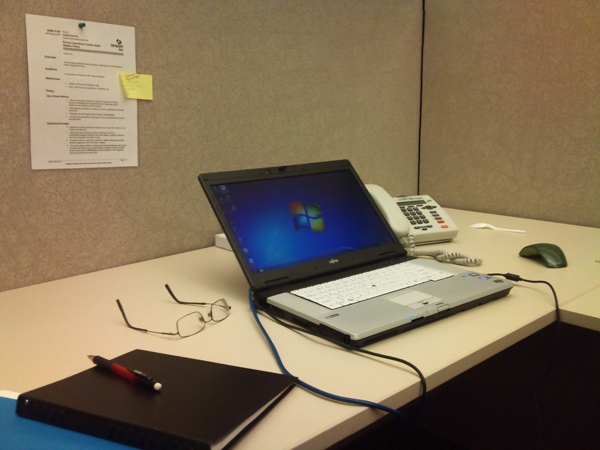
Figure 24: An indoor shot of my hoteling workspace at one of my clients', taken using only the available fluorescent lighting. Good colour balance here using the Auto setting for exposure, etc. 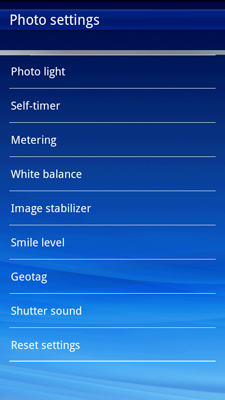 Figure 25: The settings available with the X10's camera software are extensive -- much more than I normally see for a camera phone. 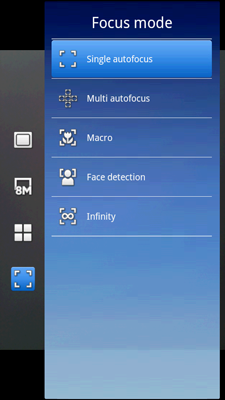 Figure 26: The X10's camera also supports a number of focus modes. 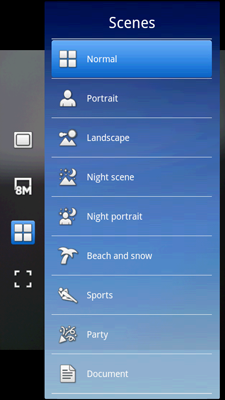
Figure 27: There are also settings for different lighting situations. Of course, the camera also includes a video mode which is capable of WVGA resolution (800x480) at 30fps. I'm not a videographer, but the test shots I took in indoor and outdoor light looked good and played very smoothly. There is also a setting for taking video specifically for uploading to YouTube.
AudioFrom working with the phone, there seem to be four different volume settings available: ringer volume, media volume, notifications/alarm volume and in-call volume. All are controlled by the volume rocker/buttons on the right side of the phone and adjust the appropriate setting contextually -- based on what you are doing at the time. For instance, selecting the Silent mode from either the Communications widget (see Figure 12) or by holding the Down Volume button doesn't turn off the media volume. To do that, you have to be playing music or a video and then turn down the volume. The ringer volume is good, depending upon the ringtone selected. The default one provided by Rogers is clearly audible outside, and from a distance. The media and in-call volumes are adequate, but only with the volume turned up almost to maximum. There's not a lot of extra 'range' available if you are hard of hearing or in a noisy environment. The notifications sound (for upcoming appointments, missed calls, etc.) is likewise very subtle and too quiet to be useful. I've missed many an appointment while having the X10 in my pocket for not hearing the reminder. VideoTo test the video playback capabilities of the X10, I made use of a number of video clips Jason provided in various formats and sample rates which we use as our test 'benchmark'. These include: - DiVx @ 500, 1000 and 1500 kbps, 320x180 and 640x360;
- h.264 @ 500, 1000 and 1500 kbps, 320x180 and 640x360; and
- WMV @ 500, 1000 and 1500 kbps, 320x180 and 640x360.
It played all of these easily except the DivX files, which weren't supported by Mediascape. However, I found a free trial of Rockplayer which played them just fine. There was some pixelation visible at the lower resolutions, and slight stutters as well at the lower bit rates/lower resolutions. Perhaps this was due to Mediascape attempting to 'upscale' them to the screen resolution. Since they were all the same clip of the movie, I was also able to check the audio synchronization and in all cases, the audio matched up perfectly to the video. The included YouTube client is very easy to use and all the videos I've selected have played very smoothly in high(er) definition. ConclusionsSo, how was the XPerience? Was there a huge difference between Android and Windows Mobile? I have to admit that after almost a month of carrying the X10 around as my primary access device, I didn't find a lot of difference between Android 1.6 with S/E's UXP and Windows Mobile with HTC's Sense interface and any of the home screen enhancements. Maybe the Android O/S came up with widgets and multiple home screens first, but these are now fairly commonplace. And to be honest, all three of the iPhone, Android and Windows Mobile interfaces are looking very similar these days. The X10 itself is a good smartphone and the screen is beautiful, but the only real 'wow' factors for me were the greatly enhanced WiFi and GPS receivers. I'm anxiously looking forward to seeing the Android 2.1 upgrade. Don is a Solution Architect with Fujitsu Consulting, specializing in Security and Project Value Management. He's been working with PDAs and Smartphones since the early days of the Sharp Wizard, iPAQ and Jornadas. As the Enterprise Mobility lead for North America, he works with clients who want to take their applications that one step further into 'mobility' by putting them right on the corporate phones. 
Do you enjoy using new hardware, software and accessories, then sharing your experience with others? Then join us on the Thoughts Media Review Team! We're looking for individuals who find it fun to test new gear and give their honest opinions about the experience. It's a volunteer role with some great perks. Interested? Then click here for more information. 
__________________
/drt
|